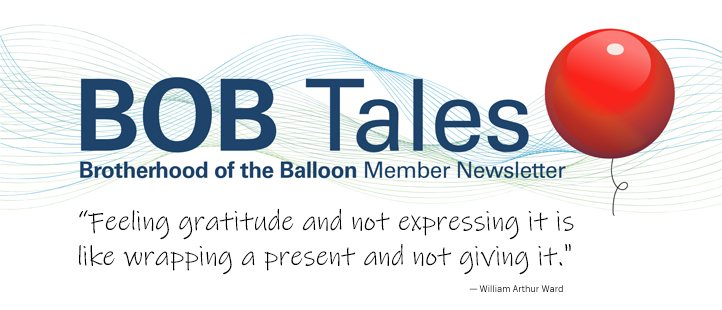

Dear Members (a note from Deb Hickey):
My daughter and I recently attempted to make a pumpkin pie. It did not go well—not only because my daughter is… determined, but because she insisted on making the crust from scratch and managed to flour-bomb the entire kitchen. And then the pie came out bland and puffy. Relatively undeterred, we ran out for more ingredients to try a different recipe, only to have the second pie turn out even worse—like a salty gelatin.
Halfway through the chaos, I caught myself pausing to take in the scene: the mess, the wasted ingredients, the time it would take to clean. I even thought how much easier it would have been to just buy a pie.
But then I caught myself. I was doing exactly what Eckhart Tolle warns against in The Power of Now. We often wish we were somewhere else—somewhere calmer, tidier, more successful—anywhere but here. But there is no “somewhere else.” The past exists only in memory, the future only in imagination. The only thing that’s real is this moment.
I decided to stop worrying and simply be there—with my daughter, the laughter, the mess, and the rich, overwhelming aroma of pumpkin. For a few minutes, that was enough.
Looking back, that day perfectly mirrors Thanksgiving itself: unpredictable, messy, and sometimes downright chaotic. And if we truly stay in the moment, we find gratitude exactly where it is—right here, in the burnt edges of a pie and in flour-covered cabinets.
In this month’s BOB Tales, we’re excited to share developments in prostate cancer care and overall health. In our opening “News Report,” we highlight a breakthrough in AI that could make prostate cancer grading more accurate—and easier to understand; a new genetic test that may help identify which patients truly benefit from hormone therapy; research revealing how a tiny DNA segment may explain inherited prostate cancer risk; and a large-scale review on dietary patterns that are reported to support prostate health.
Our “Member Spotlight” this month is John Sottosanti, whose remarkable journey as a surgeon, scientist, and endurance athlete is both inspiring and humbling. At the heart of John’s story is his profound journey of faith—a spiritual awakening that reshaped how he views life, purpose, and resilience.
In our “Healthy Living” section, discover how older adults can meet changing nutritional needs, how simple additions of fiber can make a big difference, why autoimmune diseases in men are often overlooked, and how easy dietary swaps can support heart health and overall wellness.
As always, we welcome your feedback! Just send an email to [email protected].
Deb Hickey
📄 Prefer to print and read?
👉 Download the PDF here.

- AI Breakthrough Helps Doctors Grade Prostate Cancer More Accurately—and Explain Why
- Biomarker Predicts Who Benefits from Hormone Therapy
- New Clue to Why Prostate Cancer Runs in Families
- Dietary Patterns and Prostate Health: Insights from 60 Studies
- New Data Show Prostate Cancer on the Rise
- Member Spotlight: From Prestige to Peace—Career, Faith, Health, Purpose
- The Changing Nutritional Needs of Older Adults—and How to Stay on Track
- Fiber: Small Changes, Big Benefits
- An Overlooked Threat: Autoimmune Diseases in Men

AI Breakthrough Helps Doctors Grade Prostate Cancer More Accurately —and Explain Why
A new international study introduces a promising artificial intelligence (AI) system that could make prostate cancer diagnosis more accurate and easier to understand. Called GleasonXAI, the tool was designed to “think” like a pathologist—showing not just what grade it assigns to a tumor, but why.
Anyone who’s been through diagnosis knows how much depends on those pathology slides—and how subjective grading can be. Even top specialists sometimes disagree when classifying borderline patterns, which can affect treatment decisions. Most current AI systems can help flag suspicious areas, but they tend to work as “black boxes,” giving results without showing their reasoning.
The GleasonXAI team tackled that problem by training the system on more than 1,000 prostate tissue samples reviewed by 54 expert pathologists. Unlike previous approaches, the experts didn’t just label the samples—they also annotated the features that guided their thinking, from subtle gland shapes to variations in cell structure. The AI learned from these visual clues, mimicking how human experts interpret complex slides.
The result: GleasonXAI performed as well as or better than traditional AI systems, while offering a transparent, step-by-step explanation of its decisions. That makes it easier for pathologists to understand—and to trust—the AI’s assessments.
While this technology is still in development, it could eventually help standardize grading, reduce diagnostic uncertainty, and give men clearer information about their disease from the start. For those already living with or beyond treatment, it’s an encouraging glimpse of progress—showing that smarter, more transparent AI isn’t about replacing doctors, but about improving accuracy, consistency, and confidence in care.
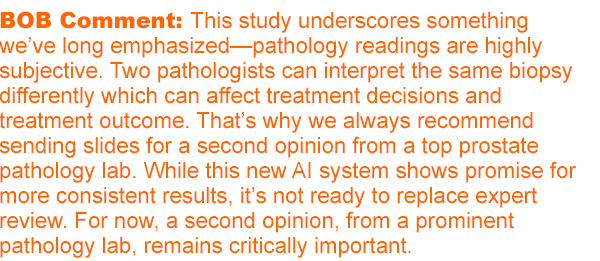

Biomarker Predicts Who Benefits from Hormone Therapy
Researchers have adapted a genetic test called PAM50—originally used in breast cancer—to help classify prostate tumors into different biological types based on how they behave. To evaluate its effectiveness, a large clinical trial called BALANCE enrolled 295 men with rising PSA after prostate surgery (but no evidence of metastasis) and randomized them to receive salvage radiation therapy (SRT) with or without the oral hormone therapy drug apalutamide (brand name Erleada).
The results were striking: for one group of patients identified by this new test, adding apalutamide reduced the risk of recurrence or death by 45% over five years compared to radiation alone. But for others, hormone therapy didn’t offer much benefit—suggesting many men could safely avoid the extra treatment and its side effects.
This marks the first prospective, biomarker-driven trial in prostate cancer to show that a test can actually predict who will benefit from hormone therapy. The finding could help doctors tailor treatment more precisely—giving hormones only to those who truly need them, while sparing others from unnecessary fatigue, weight gain, and loss of libido.

New Clue to Why Prostate Cancer Runs in Families
Scientists have discovered new clues about why prostate cancer tends to run in some families. A recent study zeroed in on a tiny section of DNA called 2p25, long linked to higher prostate cancer risk but not well understood—until now, when research suggests small changes in this region may disrupt the “on/off switches” that control key genes in prostate cells. When those switches misfire, the proteins that normally repair cell damage or respond to male hormones may not work as they should. That breakdown can make prostate cells more likely to turn cancerous.
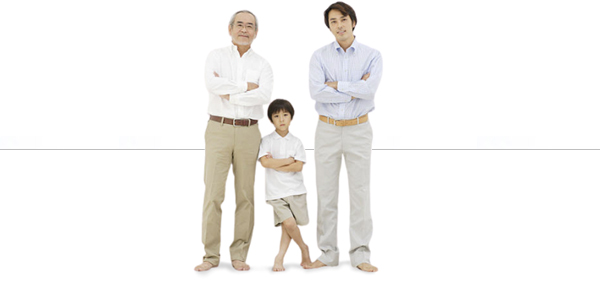
For men with a family history of prostate cancer, this finding is more than a scientific milestone—though it is still early, it’s a meaningful step toward understanding how inherited risk actually works. It could eventually lead to more accurate genetic testing and, one day, targeted prevention or treatment strategies, but such applications are not yet clinically available.
What to Ask Your Doctor About Inherited Risk
While there isn’t yet a widely used clinical test for the specific 2p25 region, there are ways to explore your inherited risk right now:
- Ask about genetic testing for prostate cancer risk genes such as BRCA1, BRCA2, ATM, CHEK2, and HOXB13—which may be considered depending on your personal and family history.
- Share your family history in detail, especially if prostate cancer occurred in close relatives or at younger ages.
- Request a referral to a genetic counselor if you have multiple family members affected; they can help determine which tests may be most informative for your situation.
Staying proactive and informed ensures that when new discoveries—like the 2p25 findings—move from the lab to the clinic, you’ll be ready to benefit from them.

Dietary Patterns and Prostate Health: Insights from 60 Studies
We’ve shared insights on holistic dietary approaches to support prostate cancer prevention and overall wellness in past newsletters, but this new large-scale review takes it to the next level. Researchers analyzed more than 60 studies—including long-term cohort studies and randomized clinical trials—to learn how overall dietary patterns affect prostate cancer risk, progression, and survival. Unlike many previous studies that focus on individual foods or nutrients, this review examines whole diets—including plant-based, Mediterranean, and low-inflammatory eating patterns.

The findings are encouraging: healthy dietary patterns may reduce prostate cancer risk, slow disease progression, and even lower prostate-cancer-specific mortality. Diets that support heart and metabolic health may offer additional benefits, especially for men with prostate cancer, who often face higher risks of cardiovascular disease and diabetes.
While observational studies showed promising associations, randomized trials produced mixed results, likely due to differences in study design, diet definitions, and follow-up duration. The authors emphasize the need for large, well-designed trials to confirm these findings and provide clear guidance on dietary patterns for prevention and management.
This review stands out for its holistic approach, examining overall dietary patterns rather than individual foods, and providing the most complete view yet of how diet affects prostate health.

New Data Show Prostate Cancer on the Rise
New national data from the American Cancer Society show a concerning trend: prostate cancer diagnoses are climbing again, and the long decline in death rates is slowing. After years of improvement, cases of advanced disease are rising fastest—about 4–5% each year—while the decline in deaths has slowed to less than 1% annually.

Experts believe this may be partly due to fewer men having PSA tests, which can mean cancers are being caught later when they’re harder to treat. At the same time, screening too broadly can bring its own challenges, such as false alarms and unnecessary treatment. Doctors continue to stress individualized screening—especially for men with family or genetic risk.
The report also highlights persistent racial disparities: Black men remain far more likely to die from prostate cancer than white men, even with similar access to care. Advocates are pushing for better education, early testing, and legislative efforts like the PSA Screening for HIM Act, which could remove financial barriers for high-risk men.
For those of us who’ve already faced prostate cancer, these findings are a powerful reminder of how far we’ve come—and how much work remains. Sharing personal experiences, supporting awareness campaigns, and encouraging informed testing can make a real difference. Progress continues when we stay proactive, informed, and united.

We’ve been publishing BOB Tales for nearly 25 years, sharing thousands of articles—many of which our newer members haven’t seen, and longtime members may have forgotten or would appreciate revisiting. That’s why we regularly reprint articles from past issues that we believe are still relevant and carry an important message. The following is an article from our Jan. 2012 issue.
Be Careful with Colonoscopies After Radiotherapy
Some patients may experience rectal bleeding after treatment, a condition known as radiation-induced neovascularization or radiation proctitis. Bleeding is usually minor, painless, and self-limiting, often appearing weeks to months after treatment and resolving on its own. Still, a colonoscopy is recommended to ensure the bleeding isn’t caused by another issue. If bleeding is persistent, heavier than usual, or accompanied by pain, patients should contact a healthcare professional promptly.
A key caution involves a small irritation on the anterior wall of the rectum, right next to the prostate. This mark typically indicates where overlapping radiation touched the rectum and can be the source of bleeding. Radiation oncologists advise that gastroenterologists avoid biopsying this spot, as doing so can lead to more severe bleeding complications.
Most gastroenterologists are aware of this precaution, but a few are not, and some of our members have experienced issues. In most cases, the bleeding resolves on its own, and treatment options are available if needed. Therefore, it is important to leave the irritated spot alone—some consider a badge of honor from proton treatment.

From Prestige to Peace—Career, Faith, Health, Purpose
John Sottosanti’s life reads like a modern epic. Surgeon, scientist, entrepreneur, educator, and author—he pursued excellence in every arena he entered. From the son of Sicilian immigrants, he rose to become a respected leader in medicine, academia, and beyond. Yet behind the accolades lay a story of quiet despair and an unexpected health battle—both of which reshaped what success truly meant to him.
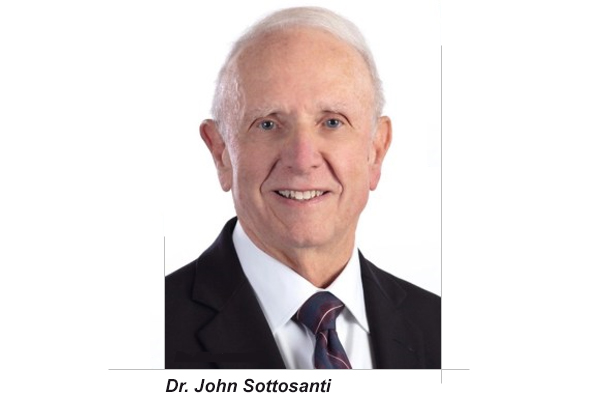
John was inspired early by his immigrant father to pursue a career in medicine, valuing the respect and stability it could bring their family. He went on to earn a DDS from Georgetown University, then served three years as a captain in the Air Force Medical Service during the Vietnam War as a general dental officer. Following that, he completed postdoctoral training in periodontics and oral surgery at the University of Southern California (USC) and the West Los Angeles VA Medical Center.
John held a private practice in San Diego for many years while simultaneously teaching at Loma Linda University (curiously!), traveling early each week to fulfill both commitments. He chaired and moderated the Annual USC Periodontal Symposium for 27 years, published more than 20 scientific articles, and developed patents on innovative bone regeneration techniques, reflecting the extraordinary breadth of his expertise. He has treated a wide range of patients, from movie stars to Nobel Prize–level scientists, including Francis Crick, the co-discoverer of DNA.
Spiritual Awakening
John’s relentless drive had taken him far, but it also left him restless. Beneath the honors and outward success lingered an emptiness that achievement alone couldn’t fill. He began searching for something deeper—something that prestige and accomplishment could never provide.
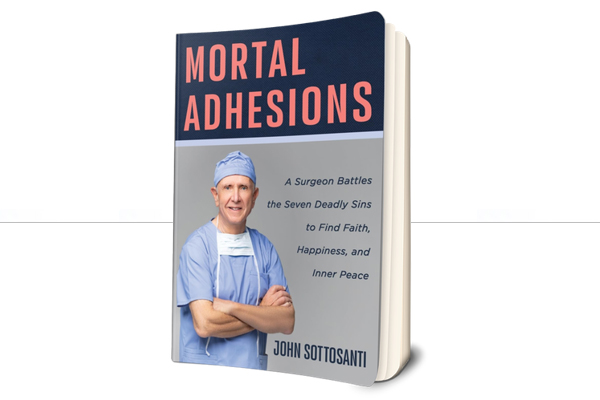
That search eventually led him to the Camino de Santiago, the centuries-old pilgrimage across Spain. Mile by mile, the journey stripped away layers of ego and ambition, opening space for reflection, humility, and grace. It became more than a physical challenge; it was a spiritual awakening that reoriented his life.
This journey of faith and self-discovery ultimately became the foundation for his memoir, Mortal Adhesions: A Surgeon Battles the Seven Deadly Sins to Find Faith, Happiness, and Inner Peace. The Amazon best-seller chronicles how John’s pursuit of prestige and fortune gave way to a deeper understanding of fulfillment, faith, and resilience.
Facing a Frightening Diagnosis
That spiritual grounding would prove invaluable just a few years later when John faced one of the greatest trials of his life: a cancer diagnosis. As a practicing periodontist and oral surgeon, John always took detailed histories, carefully reviewing prior health conditions, medications, and risks with each patient. One day, a patient checked off a box indicating he had previously had prostate cancer. Curious, John asked how he was doing now, 10 years later. The man replied that he was doing great: “I’m completely cured. I had proton therapy at Loma Linda University Cancer Center.” He was so positive and enthusiastic about his experience that John made a mental note to look into proton therapy if he were ever diagnosed himself.
As fate would have it, in 2008, John, age 66, received a diagnosis that would shake anyone: aggressive prostate cancer that had spread outside the gland…
For someone who had spent a lifetime as a doctor, it brought an unexpected perspective. “It’s so hard to be a patient when you’ve been the doctor your whole life,” he reflected. Anxiety set in immediately. He read every book and paper he could find about prostate cancer and the many treatment modalities, consulted with multiple specialists, and even devoured a three-inch-thick manual on prostate surgery from Johns Hopkins.
John ultimately chose to begin hormone treatment, which lowered his PSA from 9.7 to nearly zero in a matter of weeks. This gave him time to continue his extensive research.
At a major San Diego cancer center, two doctors recommended two treatments: surgical removal and external beam radiation. But John wasn’t convinced. The potential side effects of surgery were daunting, and he wasn’t drawn to conventional radiation either, knowing it could damage surrounding structures in the body.
Remembering his former patient, John searched for “proton therapy Loma Linda” in Google and found Bob Marckini’s book. “It was a lifesaver,” John said. Shortly thereafter, he visited LLUCC to make sure proton therapy was the right choice for him. He toured the hospital and treatment gantries, attended the patient “Wednesday Night Meeting” where patient graduates share their stories with new patients, and joined an alumni luncheon where he sat at a table of eight former patients. “Everyone sitting with me had proton therapy,” John recalled. “And they all said the same thing—it was easy. In fact, it was enjoyable—‘a radiation vacation.’ ”
This sealed the deal. John signed on for proton treatment. “It was the clear choice,” he said. “Less invasive, fewer side effects, and perfectly aligned with my physically active lifestyle.”
Riding Into Recovery
Although John began proton therapy with some apprehension, the staff and doctors at LLUCC quickly put him at ease. Their kindness and encouragement, combined with the camaraderie of fellow patients, made treatment feel far less intimidating. “I also had minimal side effects—just temporary urinary frequency and mild skin redness,” John said. “It was almost as if I never had any treatment.” John felt his proton treatment not only preserved his strength, it made him feel even stronger, empowering him to accomplish things he never imagined possible at his age.
John was an accomplished endurance cyclist, having ridden in at least five countries before his diagnosis. He maintained his fitness during treatment, making full use of LLUCC’s Drayson Center gym, racing against others on advanced stationary bikes, and even completing a Palm Springs Century ride—over 100 miles—in February 2009, in the middle of treatment!
Just months after finishing his treatment in March 2009, John returned to the road in spectacular fashion. That September, he brought his wife with him to cycle the 500-mile Camino de Santiago, crossing three mountain ranges, without any issues related to cancer treatment. In 2012, he tackled a seven-day bicycle trip in the Andes Mountains of Argentina, and two years later, he rode in the Dolomites of Northern Italy, scaling legendary Giro d’Italia peaks conquered only by the toughest professional riders.
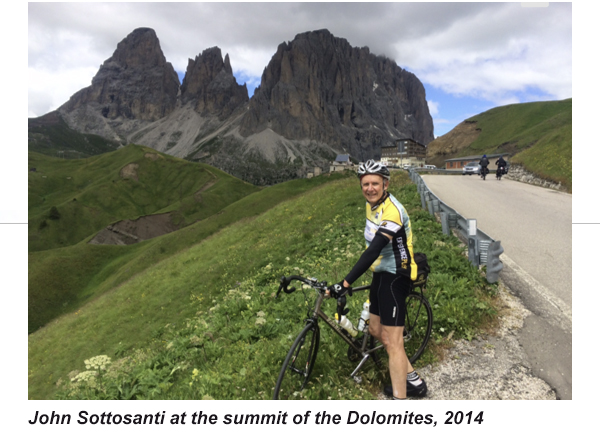
John’s determination and discipline extended beyond his own health. A long-time supporter of charitable causes, he had previously joined the Leukemia & Lymphoma Society, riding numerous century events to raise funds for patients and research. He has twice completed California’s infamous “Death Ride,” a 129-mile one-day ride in the High Sierras, demonstrating extraordinary endurance and commitment. Even after his cancer journey, John’s drive and spirit never waned. He didn’t pick up golf until age 70—but once he did, he quickly became competitive, ultimately earning the title of “Super Senior of the Year” in a year-long tournament open to players over 55. His trophy is not only a mark of athletic achievement but a symbol of resilience, perseverance, and the joy of embracing life at every stage.
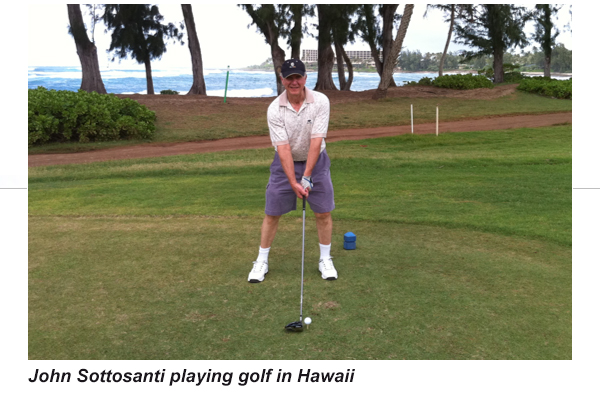
Since publishing his book, John has shared his story widely through radio, TV, podcasts, and print. He appeared on the national TV program At Home with Jim & Joy in March 2024, followed by Bookmark in April 2024—both on EWTN. On the radio, he has been featured on several stations, including Catholic Sports Radio this past June, where he discussed faith, fitness, and endurance. He has also appeared on multiple podcasts, most recently on iHeart’s Faith, Medicine, and Miracles with the Ruth Institute.
In recent weeks, his short article, “A Dental Surgeon’s Observance of Teeth in the Image on the Shroud of Turin,” has sparked a remarkable flurry of media attention.
He’s been featured on Newsmax TV, including a 50-second segment and a five-minute interview on Newsline discussing the anatomical details of the Shroud and his unique dental observations. His work has also been highlighted in The Blaze, Newsmax.com, and the Daily Mail. And in an interesting twist, a poem inspired by his findings—“Shrouded in Mystery”—was published by Light magazine.
“These past few weeks have been unbelievable,” John said. “I never imagined that a single short article could create so much interest. It’s been a whirlwind of interviews, articles, and podcasts—but it’s all been exciting and humbling.”
A sequel to Mortal Adhesions is already in the works, picking up where this memoir leaves off—right as he began his proton treatment at LLUCC—and continuing his journey of faith, endurance, and personal transformation. Stay tuned.

Supporting the Next Era of Cancer Care
As we approach the end of the year, many of us reflect on our blessings and consider the causes closest to our hearts. Last month, Dr. Richard Hart, president of Loma Linda University Health, shared an inspiring letter with our members describing the cancer center’s vision to unite four of the most advanced cancer therapies—FLASH proton therapy, CAR T cell therapy, theranostics, and boron neutron capture therapy (BNCT)—under one roof. This bold initiative represents the next era of cancer care, combining innovation, precision, and compassionate whole-person treatment.
For decades, our members have generously supported Loma Linda University Cancer Center (LLUCC), the pioneer in hospital-based proton therapy. Because LLUH was the first to bring proton therapy into a hospital setting, they set the stage for the many other proton centers where our members have been treated. As a result, even members who weren’t treated at LLUCC have made gifts in appreciation. Your ongoing support has sustained this legacy of innovation and made advanced, life-changing treatments accessible to patients from around the world.
Now is a pivotal moment. Your gifts can accelerate the development of these therapies, expand patient access, and train the next generation of physicians and researchers—helping thousands more receive the benefit of precision, compassionate care.
Please consider a year-end gift to LLUCC. Every contribution helps advance this new vision of cancer care and ensures patients today and tomorrow have access to treatments that could save their lives. Thank you for your generosity, your trust, and your commitment to a brighter future in cancer care.

Giving Options
- Online: Donate here. From the pull-down menu, choose where you’d like to direct your gift — 1) Cancer Center Vision/Stronger Together; 2) Proton Research through the James M. Slater Chair; 3) Proton Research through the Robert J. Marckini Chair; or 4) Other (specify any area you’d like your gift directed in the space provided).
- By Check: Make your check out to “LLUCC.” Specify where you’d like to direct your gift in the memo line — 1) Stronger Together 2) Slater Chair, 3) Marckini Chair, or 4) write “unrestricted” so LLUH can use it where it’s needed most. Mail your check to: LLUH, Office of Philanthropy P.O. Box 2000, Loma Linda, CA 92354.
- By Phone: Call Regina Joseph at 909-558-5010.
- Planned Giving: You can also include LLUCC in your estate plans, creating a lasting legacy that will help advance cancer research and patient care for generations to come. For more information or to schedule a confidential consultation, please contact the planned giving office at 909-558-4553 or [email protected].

The Changing Nutritional Needs of Older Adults
As we get older, our bodies don’t work the same way they used to—and that includes how we digest and use food. With age comes a range of changes that affect what our bodies need to stay healthy. Muscle mass and strength, which start to decline slowly in our 40s, tend to drop more rapidly in our 60s. This loss of muscle slows metabolism, and combined with lower activity levels, thinning bones, and reduced mobility, it can make maintaining health even more challenging.
Recognizing these changes, the federal government’s Dietary Guidelines for Americans include a dedicated section for older adults, offering guidance on how to adjust eating patterns to meet evolving nutritional needs. The guidelines recommend nutrient-dense foods such as lean meats, fish, beans, whole grains, fruits, vegetables, and low-fat dairy, while limiting added sugars, saturated fats, and overly processed foods.
Protein becomes increasingly important with age, as it helps preserve muscle mass, while vitamins D and B12 and calcium support bones and nerve health. Hydration also plays a critical role, since older adults often drink less and may not feel thirsty as easily. Eating patterns such as the Mediterranean diet and the DASH diet (Dietary Approaches to Stop Hypertension) are excellent frameworks. The DASH diet emphasizes non-starchy vegetables, fruits, whole grains, and legumes, while limiting salt, added sugar, tropical oils, alcohol, and processed foods—making it a strong choice for heart and overall health.

Of course, putting this advice into practice isn’t always easy. A USDA analysis of federal health data from 2020 found that fewer than half of U.S. adults age 71 and older met the recommended guidelines for healthful eating. Men in this age group did slightly better with protein and dairy, but fewer than 25% were meeting vegetable, fruit, and dairy goals. Making small, consistent adjustments to your diet can make a meaningful difference, no matter your age.

Fiber: Small Changes, Big Benefits
Most of us don’t get nearly enough fiber—and it’s one of the easiest ways to keep your body running smoothly as you age. Fiber helps digestion, supports heart health, steadies blood sugar, and even keeps you feeling full longer.
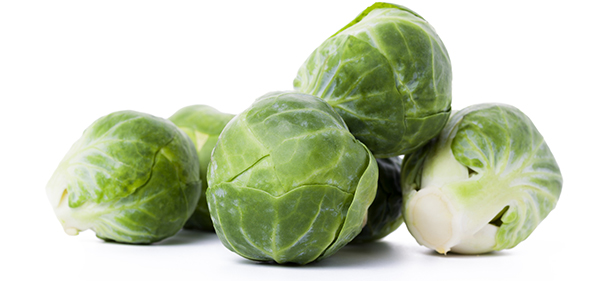
Adding fiber doesn’t have to be complicated. Start your day with berries or oatmeal, toss beans into soups or salads, snack on almonds, or pile roasted broccoli and sweet potatoes on your plate. Even sprinkling chia seeds into yogurt or replacing white bread with whole grains gives your diet a boost.
With just a few simple swaps from these 32 fiber-rich foods, you can strengthen your health in ways that really add up—without changing the foods you already love.

An Overlooked Threat: Autoimmune Diseases in Men
Autoimmune diseases are often thought of as conditions that mostly affect women—but research shows that millions of men live with them too, often without knowing it. A recent study estimates that about 5.7 million men in the U.S. may have an autoimmune disease.
Because autoimmune illnesses are more often associated with women, men’s symptoms—like fatigue, joint pain, or digestive trouble—are sometimes dismissed or misdiagnosed. While disorders such as rheumatoid arthritis, lupus, and multiple sclerosis are more common in women, men who develop autoimmune diseases often face delayed diagnoses and more severe complications.
Experts say several factors may explain the gap: genetics, hormones, and behavior. Estrogen tends to heighten immune activity, while testosterone dampens it—and men are also more likely to put off medical visits or minimize symptoms.
Some autoimmune conditions appear more frequently in men, including psoriasis, ankylosing spondylitis (a type of inflammatory arthritis), type 1 diabetes, and inflammatory bowel disease. Left untreated, these can have debilitating effects.
Men who notice persistent fatigue, joint pain, or unexplained digestive issues should talk with their doctor. Early attention can make a major difference in treatment and long-term health.

You Can Beat Prostate Cancer: And You Don't Need Surgery to Do It - Second Edition
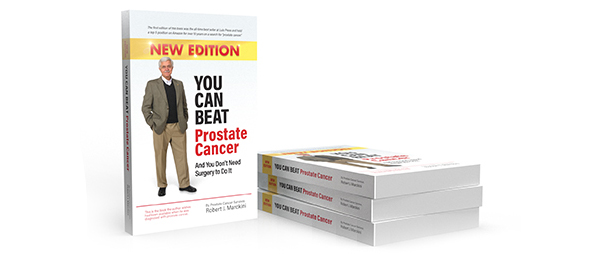
As of this writing, Bob’s second edition is still holding the No. 2 spot on Amazon—out of more than 7,000 books—on a search for “prostate cancer.” The book has 324 reviews and an average rating of five stars.
Beyond the Amazon stats, what truly matters is the feedback we hear from readers. Every day, men share how Bob’s book gave them the confidence to make one of life’s most important decisions. Some call it a “lifesaver,” others say it was the one resource that made proton therapy the clear choice. Hearing their stories reminds us why Bob wrote it in the first place
Real Words from Real Readers
Instead of featuring an Amazon review this month, we wanted to share another “real reader” review about Bob’s book. Last month’s brain teaser winner, Jim Koenig, emailed Deb after receiving his signed copy. He wrote:
I thank you from my heart for the autographed book by your dad. To me, it’s one of the most important books I've ever read. It changed my life.
What could be better than that? Nothing could mean more to us.
Did Bob’s book help you?
When diagnosed with cancer, 89% turn to the internet for answers—40% on the very same day. Many end up on Amazon, where reviews carry serious weight. If Bob’s book helped you, please take a moment to write a review. Your words could help someone else find clarity and hope. Thank you.

Last Month’s Brain Teaser
What is the weight of a fish if it weighs 10 pounds, plus half its weight?
Answer: The fish weighs 20 pounds because the 10 pounds is just half of its weight, so doubling that gives the total.
Winner: Congratulations to our October 2025 Brain Teaser winner, a member from Riverside, CA!

New Brain Teaser
Say that I have only one boomerang. Originally, I had more, but I gave half of them plus half a boomerang to my little brother. That made him
mad, so I gave him half of what I had left, plus half a boomerang more. How many boomerangs did I start out with?
Send your answer to [email protected] for a chance to win a signed copy of Bob Marckini’s second edition book, You Can Beat Prostate Cancer.

Thanksgiving
A man in Phoenix calls his son in New York the day before Thanksgiving and says, “I hate to ruin your day, but I have to tell you that your mother and I are divorcing; forty-five years of misery is enough.”
“Pop! What are you talking about?!” the son screams.
“Your mother and I have discussed this at great length,” the father says, “and we agree it’s time to call it quits, so call your sister in Chicago and tell her.”
Frantic, the son calls his sister, who explodes on the phone. “Like heck they’re getting divorced,” she shouts. “I'll take care of this!”
She calls her parents in Phoenix immediately and screams at her father, “You and Mom are NOT getting divorced. Don’t do a single thing until I get there! I’m calling my brother back and we’ll both be there tomorrow! Until then, don’t do a
thing! DO YOU HEAR ME?” And she hangs up.
The old man hangs up the phone, turns to his wife and says: “It worked. They’re coming for Thanksgiving and paying their own way.”

Senior Drivers
Two elderly women were out driving in a large car. Both could barely see over the dashboard. As they were cruising along, they came to an intersection. The light was red, but they just went on through.
The woman in the passenger seat thought to herself: I must be losing it. I could have sworn we just went through a red light.
After a few more minutes, they came to another intersection, and the light was red again. Again, they went right through. The woman in the passenger seat was almost sure that the light had been red but was really concerned that she was losing it. She was getting nervous.
At the next intersection, sure enough, the light was red and they went on through. So, she turned to the other woman and said, “Mildred, did you know that we just ran through three red lights in a row? You could have killed us both!”
Mildred turned to her and said, “Oh! Am I driving?!”

The Donation
Father O’Malley answers the phone.
“Hello, is this Father O’Malley?”
“Yes, it is!”
“This is the IRS. Can you help us?”
“Sure!”
“Do you know a Ted Houlihan?”
“I do!”
“Is he a member of your congregation?”
“He is!”
“Did he donate $10,000 to the church?”
(Pause)
“He will.”

Success Has No Age
- The founder of Kentucky Fried Chicken, Harland David Sanders (a.k.a. Colonel Sanders), started Kentucky Fried Chicken at the age of 65.
- Julia Child published her first cookbook at 50 years old. Then, she turned into a celebrity chef with her own TV show at 60.
- Author Toni Morrison didn’t explode in the public eye until 1993 when she was 62. She then became the first African American woman to win the Nobel Prize for Literature.
- Ray Kroc founded the McDonald’s System, Inc. in 1955, a predecessor of the McDonald’s Corporation, and then bought the exclusive rights to the McDonald’s name. He was 68.
- Tom Allen, Britain’s oldest yoga instructor, didn’t start practicing yoga until his mid-fifties—but now, at 90, he continues to teach with no intention of retiring.
- Grandma Moses worked on a farm most of her life. She started painting only in her late seventies.
- Award-winning screenwriter and novelist Millard Kaufman, also the co-creator of Mr. Magoo, began screenwriting in his early 30s, but his first novel, “Bowl of Cherries,” was published when he was 90.

Did You Know…?
- A cloud can weigh about a million tons. Even so, it floats because the air inside is slightly lighter than the air around it.
- Earth’s rotation is slowing down. On average, the day gets about 1.8 seconds longer every 100 years. Six hundred million years ago, a day lasted only 21 hours.
- Earlobes don’t have a clear biological purpose. They have lots of nerves and may help with social bonding, but that’s about it.
- Mars isn’t a perfect sphere. Its shape is more like a slightly squished rugby ball.
- The average color of the universe is called “Cosmic Latte.” In 2002, scientists found that the combined light from galaxies looks like a pale beige-white.
- Animals experience time differently than humans. Smaller animals, like salamanders and lizards, perceive the world more slowly than cats or dogs because their brains process information at a different speed.
- Water itself isn’t technically wet—it just makes other things wet when it touches them.
- Most people pet cats the wrong way. The best spots are under the chin, on the cheeks, and at the base of the ears. Avoid the belly and the base of the tail unless you want to annoy them.

A Ballooning Planet That Shouldn’t Be There
Astronomers have discovered a peculiar new planet that challenges our understanding of how planets form. Known as TOI-4507b, this gas giant is about the size of Jupiter, but only a fraction of its mass, making it unusually light for its size. This gives it a remarkably low density, causing its outer layers to spread out and form a balloon-like atmosphere. These rare types of planets have earned the nickname “super-puffs” because they appear much larger than they actually are.
Adding to the mystery, TOI-4507b follows an odd, nearly perpendicular orbit around its star, suggesting a chaotic past involving gravitational forces or even a collision. Discovered by NASA’s TESS satellite and confirmed by Antarctica’s ASTEP telescope, this planet offers a unique opportunity to learn more about planetary formation.
With the James Webb Space Telescope poised to study its atmosphere, TOI-4507b could soon help rewrite the textbooks on how planets come to be.


Gratitude and Giving Thanks
As we typically do this time of year in celebration of Thanksgiving, we want to express our deep gratitude to all who support our mission. Your generosity and commitment make this work possible—without you, none of it would exist. Thank you for being at the heart of all we do.
To our members: Your devotion to “the cause” continues to inspire us. Thank you for sharing your knowledge and passion for proton therapy, for your thoughtful questions, volunteer support, and messages of encouragement. We’re grateful for every newsletter you forward, every extra book you share, and every contribution you make to advance proton research and the new cancer-fighting technologies on the horizon.
To our pioneers and partners: Our deepest thanks to the late Dr. James M. Slater, Dr. Jerry Slater, and the Loma Linda University Cancer Center for pioneering proton therapy and helping tens of thousands preserve their quality of life. We’re equally grateful to Dr. Richard Hart and the Loma Linda University Health leadership for their ongoing support, and to all the proton centers advancing this life-changing treatment.
To our collaborators: Special thanks to Jennifer Maggiore and the National Association for Proton Therapy for your advocacy and education efforts; to Dr. Nancy Mendenhall and the University of Florida Proton Therapy Institute, and all involved in the COMPPARE trial for your groundbreaking work; and to Bob Hawley for your meticulous newsletter reviews that ensure we deliver excellence each month.
To our individual LLUCC partners: We’re grateful to Nancy Chansavang and the LLUCC Web team, Larry Becker and the marketing, PR, and legal teams for your outstanding support. Heartfelt thanks also to Rachelle Bussell, Randy Possinger, Judy Chatigny, and the many others on the support team we meet and communicate with regularly for helping us grow and care for our members. We extend deep gratitude to Dr. Mark Reeves and Dr. Frankis Almaguel for the generous time and attention you offer whenever we reach out—even though you are among the busiest people on the planet. Your unwavering dedication to your patients and to all those facing serious health challenges continues to inspire us.
To one man who stands on his own: We honor Dr. J. Lynn Martell for his vision and encouragement in our early days, and for the lasting impact he’s had on our journey.
Together, we’re making a difference—educating others, combating misinformation, advocating for patients, and helping raise more than $16 million to advance proton research and cancer care. We’re profoundly grateful for you and for everyone who continues to champion our mission.
Happy Thanksgiving and low PSAs to all,
Bob Marckini and Deb Hickey
Want a printable version of this issue?
👉 Download the PDF here.
NO MEDICAL ADVICE: Material appearing here represents opinions offered by non-medically trained laypersons. Comments shown here should NEVER be interpreted as specific medical advice and must be used only as background information when consulting with a qualified medical professional.
